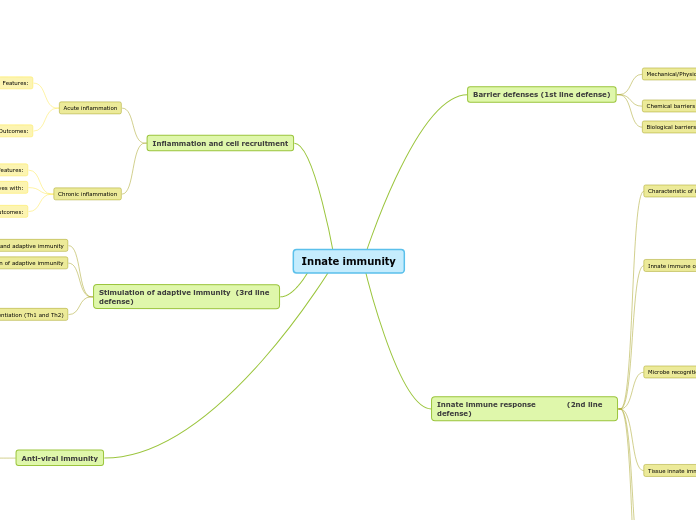Innate immunity
Barrier defenses (1st line defense)
Mechanical/Physical barriers
ex. skin
preventing
microbes from reaching tissues
tightly joined
Chemical barriers
ex. low stomach pH, lysozyme
Biological barriers
ex. normal flora
is the term used to describe various bacteria and fungi that are permanent residents of certain body sites
Innate immune response (2nd line defense)
Characteristic of innate immunity
Rapid/quick response
Non-specific responses
No memory
Innate immune cell activation by PAMPs and DAMPs
PAMPs
Derived from components of microorganisms (pathogens)
Exogenous stimuli
DAMPs
Derived from host cells such as tumor cells, dead or dying cells, products released from cells, tissue damage, etc
Endogenous stimuli
Microbe recognition by innate immune cell PRRs
PRRs are able to recognize molecules associated with pathogens i.e. PAMPs and DAMPs
PRRs can be found on the innate immune cells
Major type of PRRs
Toll-like receptors (TLRs)
NOD-like receptors (NLRs)
RIG-like receptors (RLRs)
C-type lectin receptors (CLRs)
Tissue innate immune cells
Intraepithelial lymphocyte (IELs)
are lymphocytes found in the epithelial layer of mammalian mucosal linings
an effective first line of defense
Macrophages
secretes inflammatory cytokines that support immune responses.
Peripheral blood immune cells
NK cells
-recognize MHC I
-Produce high levels of cytokines
Neutrophils
are important effector cells in the innate arm of the
immune system.
Dendritic cells
are professional antigen-presenting cells
Eosinophils
is involved in host protection against parasite infection and
immunopathology in hypersensitivity disease
Basophils
Monocytes
Humoral substances of innate immunity
Cytokines, mediators, complement system
Inflammation and cell recruitment
Acute inflammation
Features:
Involves the innate immune system
5 cardinal signs: redness, increased heat, swelling, pain, loss of function
Outcomes:
1. Local hemodynamic changes (vasoconstriction → vasodilation)
2. Increase in vascular permeability
3. Extravasation of leukocytes
4. Phagocytosis
5. Outcome of inflammatory response
Chronic inflammation
Features:
Prolonged exposure to toxic pathogens
Mechanism involves with:
Pro-inflammatory(IFN-γ)and anti-inflammatory (IL-4andIL-13)
Outcomes:
• Scarring
• Amyloidosis
• Neoplasia
Stimulation of adaptive immunity (3rd line defense)
Interplay between innate and adaptive immunity
Activation of adaptive immunity
T cell activation and differentiation (Th1 and Th2)
Th1
-cell-mediated immunity and inflammation
-intracellular pathogens
-autoimmunity
-inflammation
Th2
-antibody-mediated immunity
-extracellular parasites
-asthma, allergy
Anti-viral immunity
type I IFNs (α/ß) or IFN-I
primary source of IFN-I for antiviral responses
detect RNA and DNA viruses with two endosomal sensors, TLR7
and TLR9
